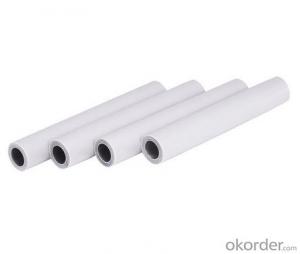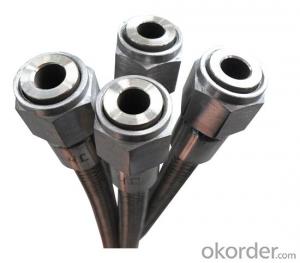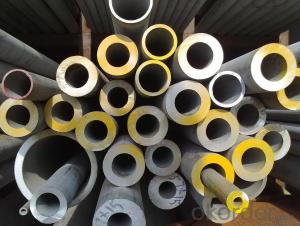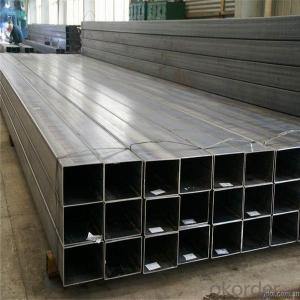Stainless Steel corrosion resistance Pipe Stainless Steel Tube 304/316L
- Loading Port:
- Huangpu
- Payment Terms:
- TT OR LC
- Min Order Qty:
- 100 pc
- Supply Capability:
- 100000 pc/month
OKorder Service Pledge
OKorder Financial Service
You Might Also Like
Specification
WELCOME to visit our stainless steel products here(^_^)
Press fitting system joins pipe without welding or bolting. The components fit by crimping through the use of a special pressing tool. An O-ring that is inserted in the fitting ends of the pipe ensures a leak-proof connection. Press fitting system is the trend of pipeline industry. It is widely used in cold and hot water supply, heating supply, fire protection, medicinal gas, industrial petroleum pipeline system etc.
For the size, now we have 3 series:
1. Out diameters: 16.0, 20.0, 25.4, 32.0, 40.0, 50.8, 63.5, 76.1, 88.9, 108.0 (GB/T 19228.2-2011)
2. Out diameters: 15.88, 22.22, 28.58, 34.0, 42.7, 48.6, 76.1, 88.9, 101.6 (JIS G3448-1980)
3. Out diameters: 15, 18, 22, 28, 35, 42, 54, 76.1, 88.9, 108 (EN 10312:2002)

Technical information:
-- Material: Stainless steel 304 and 316L available.
-- Max working pressure 1.6MPa (equal to 232 psi), testing water pressure: 2.5MPa (equal to 362.5psi).
-- Working temperature from -20 to 110 degree centigrade (with Chlorinated butyl rubber O ring),
-- Suit medium: Cold water, hot water, compressed air, gas, oil etc
The product features as below:
1, thin wall stainless steel pipe could last for 70 years, it is the same life time with normal buildings.
2, no smell, no rusty.
3, recycle material
4, avoid welding, avoid fire dangerous.
Contact us for more details!
- Q: What is the difference between 304H and 304L stainless steel pipes?
- The main difference between 304H and 304L stainless steel pipes lies in their carbon content. 304H stainless steel pipes have a higher carbon content, typically around 0.04-0.10%, which makes them suitable for high-temperature applications. This higher carbon content provides improved high-temperature strength and resistance to sensitization, which is the formation of chromium carbides at grain boundaries, leading to reduced corrosion resistance. On the other hand, 304L stainless steel pipes have a lower carbon content, usually around 0.03%, which makes them more suitable for welding applications. The lower carbon content helps to minimize the formation of chromium carbides, thus reducing the risk of sensitization during welding. This results in improved corrosion resistance and enhanced weldability. In summary, while both 304H and 304L stainless steel pipes are variants of the 304 grade, the difference lies in their carbon content. 304H pipes are preferred for high-temperature applications due to their higher carbon content and improved high-temperature strength, while 304L pipes are more suitable for welding applications due to their lower carbon content and enhanced weldability.
- Q: Advantages and disadvantages of PPR lined stainless steel pipe and PPR aluminium plastic pipe
- 1 、 aluminum plastic composite pipe including lap welding aluminum plastic composite pipe and butt welding aluminum plastic composite pipe, butt welding, the thickness of the aluminum strip and welding process requirements are relatively high.2, the existence of lap welding aluminum layer, increased the modulus of the pipe, and the wall thickness is more thick, installation of pipe is more difficult to bend, need to use more pipe fittings for connection, therefore, field construction is more difficult than PP-R. And the plastic aluminum steady state composite tube must first strip off the outer protective layer, the adhesive layer and the aluminum layer before welding, and then can connect. If the adhesive layer is not clean, it will lead to welding unreliable and leak point.
- Q: Stainless steel why rust?
- Stainless steel surface adhesion of organic juice (such as vegetables, soup, sputum), oxygen in the water under the circumstances, a long time, organic acid, organic acid on the surface of metal corrosion.
- Q: How can the inner walls of stainless steel tubes be polished?
- Electropolishing is thrown to the workpiece as anode, insoluble metal poles at the same time as the cathode, immersed into electrolytic cell, with the direct current produced anodic dissolution selectively, so as to achieve the surface brightness increasing effect. Specific can be used to search "what is electrolytic polishing" can understand!
- Q: What is the difference between seamless and seamless stainless steel pipes?
- The difference between seamless and seamless stainless steel pipes lies in the manufacturing process and the composition of the material used. Seamless pipes are manufactured by extruding a solid billet through a piercing rod to create a hollow tube. This process eliminates the need for any welds or joints, resulting in a continuous and smooth pipe with no weak points. Seamless pipes are known for their strength, durability, and ability to withstand high-pressure and high-temperature applications. They are commonly used in industries such as oil and gas, petrochemical, and power generation. On the other hand, seamless stainless steel pipes are a specific type of seamless pipe that is made from stainless steel. Stainless steel is an alloy that contains a high percentage of chromium, which provides excellent corrosion resistance and high-temperature strength. This makes seamless stainless steel pipes suitable for applications where resistance to corrosion, oxidation, and heat is crucial, such as in the food and beverage, pharmaceutical, and chemical industries. In summary, while both seamless and seamless stainless steel pipes are manufactured through a seamless process, the difference lies in the material used. Seamless stainless steel pipes offer the added benefits of corrosion resistance and high-temperature strength due to their stainless steel composition.
- Q: Can stainless steel pipes be used for pharmaceutical storage tanks?
- Yes, stainless steel pipes can be used for pharmaceutical storage tanks. Stainless steel is a preferred material in the pharmaceutical industry due to its high corrosion resistance, durability, and ability to maintain cleanliness. It is non-reactive, which helps prevent contamination of the pharmaceutical products stored in the tanks. Stainless steel pipes also offer a smooth and easy-to-clean surface, making it suitable for maintaining the required hygiene standards in pharmaceutical storage. Additionally, stainless steel is resistant to extreme temperatures and can withstand the rigorous cleaning procedures commonly used in pharmaceutical facilities. Thus, stainless steel pipes are commonly used in the construction of pharmaceutical storage tanks to ensure the safety and integrity of the stored pharmaceutical products.
- Q: Can stainless steel pipes be anodized?
- No, stainless steel pipes cannot be anodized. Anodizing is a process used to create a protective layer on the surface of metals, primarily aluminum. Stainless steel already has a naturally occurring oxide layer that provides corrosion resistance, making anodizing unnecessary.
- Q: Why can stainless steel pipes be welded by argon arc welding?
- Argon arc welding arc welding, convenient operation and observation; electrode loss is small, easy to maintain the arc length, welding flux free, coating layer, so it is easy to realize mechanization and automation; argon arc welding welding can almost all metals, especially some refractory metal, oxidizable metals, such as magnesium, titanium, molybdenum zirconium and aluminum and its alloys; by the welding location restrictions, can be used for all position welding.
- Q: What is the difference between 440C and 440F stainless steel pipes?
- 440C and 440F are both types of stainless steel that belong to the 440 series. However, they have slight differences in their composition and properties. 440C stainless steel is a high-carbon martensitic stainless steel that contains chromium, which enhances its corrosion resistance and hardness. It is known for its exceptional wear resistance, good strength, and ability to maintain sharpness. Due to its high carbon content, it offers excellent hardness, but it may be more difficult to machine compared to lower carbon stainless steels. 440C is commonly used in applications where high strength, corrosion resistance, and wear resistance are required, such as in cutting tools, bearings, and surgical instruments. On the other hand, 440F stainless steel is a free-machining version of 440C. It is also a high-carbon martensitic stainless steel but with added sulfur, which improves its machinability. The sulfur acts as a lubricant during the machining process, enabling easier and faster cutting. However, the addition of sulfur slightly reduces its corrosion resistance and toughness compared to 440C. 440F is often used in applications that require extensive machining, such as in automotive components, fasteners, and valve parts. In summary, the main difference between 440C and 440F stainless steel pipes lies in their machinability and sulfur content. 440C offers higher corrosion resistance and hardness but may be more difficult to machine, while 440F is easier to machine but has slightly reduced corrosion resistance and toughness. The choice between the two depends on the specific requirements of the application, with 440C being preferred for applications that prioritize corrosion resistance and wear resistance, and 440F being used when extensive machining is required.
- Q: What is the average lifespan of stainless steel pipes?
- The average lifespan of stainless steel pipes can vary depending on several factors, including the quality of the stainless steel used, the environment in which the pipes are installed, and the maintenance and care they receive. However, as a general estimate, stainless steel pipes can have a lifespan of 50 to 100 years or more. This is due to the inherent corrosion resistance of stainless steel, which helps to protect the pipes from rust and other forms of degradation. Additionally, stainless steel pipes are known for their durability and strength, allowing them to withstand high temperatures, pressure, and other harsh conditions. With proper installation and maintenance, stainless steel pipes can provide long-lasting and reliable performance in various applications, such as plumbing, industrial processes, and construction projects.
Send your message to us
Stainless Steel corrosion resistance Pipe Stainless Steel Tube 304/316L
- Loading Port:
- Huangpu
- Payment Terms:
- TT OR LC
- Min Order Qty:
- 100 pc
- Supply Capability:
- 100000 pc/month
OKorder Service Pledge
OKorder Financial Service
Similar products
Hot products
Hot Searches
Related keywords


























